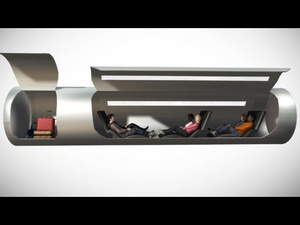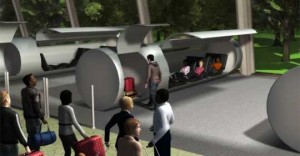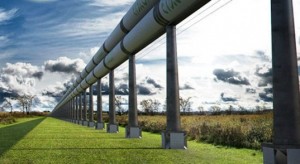ET3: Evacuated Tube Transports People Five Times the Speed of Sound
The internet and the airplane have combined to tear down boundaries worldwide and fuel the globalization fire. Standing on two continents in one day was absolutely unfathomable even one hundred years ago. Businesses are now thriving with a global reach, while the Earth is currently at the most peaceful time in it’s history. Communication and collaboration brought upon by technology have been fundamental to this shift.
These two history-changing inventions that accelerated globalization on it’s current path are the new inspiration for taking humanity to the next level. A patented transportation concept that is as lightning quick and connected as the internet is gaining funding, and prototypes are set for the immediate future. Evacuated tube transport will rock your world.
Evacuated Tube Transport
ETT, ET3 or Evacuated Tube Transport is a radical form of future human and cargo transport than can reach Earthly speeds of up to 4,000 mph! There’s a real reason ETT is being called ‘Space Travel on Earth.’ ET3 is a proposed alternative to cars and aircrafts; it consists of a number of lightweight passenger capsules that are frictionlessly shot through an enclosed tube using magnetic levitation, similar to a maglev train. The current models of the maglev have been lauded for their energy efficiency, and awesome speeds of up to 350 mph. What makes the ET3 so incredible, and what enables such unheard of speeds, is that the tube system creates an airless vacuum around the maglev-like base for the pods/capsules to be fired through. There is almost zero drag involved, as the pods make no contact with a track and are not slowed by air like the traditional maglev.
Esteemed engineer and ET3 mastermind Daryl Oster believes the idea will enable travel from New York to Los Angeles in 45 minutes, as well as Washington D.C. to Beijing in two hours! These capsules are accelerated through the tube (made of an array of area specific materials) using electric motors in the track. Once in motion, the capsule will coast using a magnetic current, consuming almost no energy. What’s amazing about the patented concept is that the energy that is initially required to accelerate the capsule is almost entirely regenerated during the ensuing braking process, which is done automatically by the tube track. The ET3 website estimates that evacuated tube transport can “provide 50 times more transportation per kilowatt hour (measure of electric energy) than electric cars or trains.”
ET3 Specifications
The specs of the invention are pretty remarkable. A particular capsule will weigh a miniscule 400 pounds, with capacity to transport up to six passengers, or 800 pounds of cargo. ET3 can be built for 1/4 the cost of a freeway, while doing the job of one that contained 32 lanes! When riding inside a capsule, the human body would actually fare excellently, feeling only 1G of force, much less than a rollercoaster (about 3G’s of force). This absence of strain on the body is due to the linear nature of the tube, and the gradual process of acceleration and deceleration. Rapid movement in any direction directly impacts the amount of force on the body.
ETT Feasibility
While the idea may sound farfetched, the technology is actually comprised completely of things that are available to us today. The biggest difficulty would be creating airtight tubes that were straight enough, while not being subject to movement or manipulation in any way shape or form. Oster believes this is attainable. The idea would create potentially the most sustainable form of transportation to date; and engineless pod with zero emissions and with the potential to run on solar energy. It’s also shockingly affordable, with estimations at travel costs being less than one penny per mile traveled! The issue of having breathable air inside of an airless tube has been shown to work within submarines and spacecrafts. If you’re the claustrophobic type, these pods will contain amenities, as well as emergency escape hatches built into the tube at every mile juncture.
A Worldwide Effort
Oster has visions of a collaborative worldwide approach to evacuated tube transport implementation. He is offering incentives on his website for anyone who is able to contribute intellectually, physically or financially to making the project a reality. While it’s tough to believe in an invention without seeing a working model, the concept is scientifically sensational, and is feasible using affordable technology that we already have. China is taking the first big step and building transport tubes that they hope will be up and running within three years to a decade, and Oster himself is currently in talks to get a test track built in California. There will be obviously be opposition from those with ties to any type of transportation or fuel industry, but Daryl is optimistic that those can be overcome.
On a smaller scale this idea could revolutionize shipping, and potentially save the fledgling United States Postal Service. For the costs that Oster is describing, sending an important item across the world in mere hours could be a distinctly affordable possibility. This may be the place to focus on initially, although Oster is firm in his belief that this is a real possibility for transportation today. There has also been talk of this technique enabling us to launch crafts into space by building an upward facing tube, which certainly could aid those looking to get into the asteroid mining industry.
Just as the internet and airplane connected the world and broke down seemingly impenetrable barriers, the evacuated tube could have the same effect.
Comments
Tags: daryl oster, ET3, ETT, evacuated tube, evacuated tube transport, fastest train, fastest train in the world, maglev train, magnetic train
Trackback from your site.




Comments (2)
Trekkie
| #
Emergency escape hatches at potentially 4000 miles per hour? What does that entail? The airline industry has struggled for a long time, how are they going to feel about this kind of competition. Perhaps, they will invest and phase out their air flights maintaining some for the nostalgic minded. I would also be curious about how we would build a tube transport across the ocean? Maybe because of the speed and subsequent time savings, the “track” can take a long route over as much land as possible and cut across the shortest expanse of ocean (I need to get a globe out). This would be phenomenal and would likely provide lots of jobs at least ’til all systems are in place; hopefully by then, all of the displaced airline workers will have moved on to tube pilots, tube attendants, tube mechanics etc. I wonder if Fed Ex would want to have their own tube system or perhaps as a joint venture, everyone would get to take turns and profit. Not sure how viable shooting up to space in a tube is, what might that look like? Given you would want the tube tracks raised, what kind of resistance will likely result from environmentalists, and individual towns, cities etc. who want to preserve their views etc. Tricky business but wow! China in two hours, think of the increase in travel since you would no longer need an extended vacation period to travel abroad. Ka-ching!
Reply
Dennis
| #
I agree with Trekkie’s insights and questions…new technology always has its issues…to one point: rights of way of the railroads/highways could provide the land for the tubes…
Reply